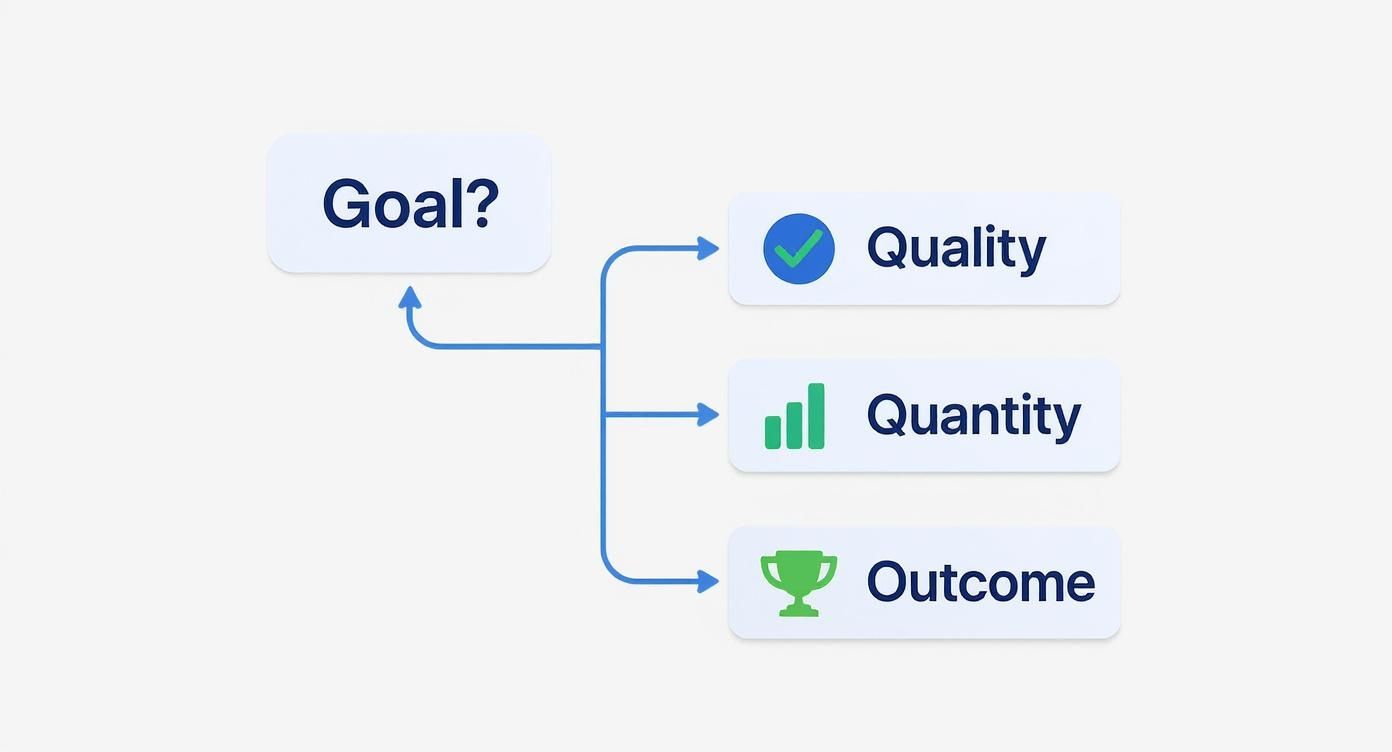To really get a handle on team productivity, you have to look at the right things. It's not about counting hours worked or tasks checked off a list. The real story is in the outcomes, the quality of the work, and the team's overall efficiency. The goal is to measure the team's collective impact on the business, making sure the work they're doing is both valuable and sustainable.
Rethinking What Team Productivity Really Means
For decades, productivity was a simple factory-floor equation: output divided by input. More widgets per hour meant you were winning. But in today's world of creative and knowledge-based work, that model is completely broken.
Counting lines of code, emails sent, or hours logged just doesn't capture a team's true value. This outdated approach often just rewards "busyness" over meaningful progress and leads straight to burnout. Real productivity isn't about doing more; it’s about the team doing the right things effectively. That requires a totally different way of thinking.
The Modern View on Performance
A modern take on team productivity is much more holistic. It looks beyond what was produced and digs into how it was made and the long-term impact it has.
This new perspective is built on a few key ideas:
- Collective Impact Over Individual Activity: The focus shifts from what one person did to what the team accomplished together for the company.
- Quality and Innovation: How good was the work? Did it actually solve the customer's problem or help the business get ahead?
- Team Well-being and Sustainability: A burnt-out team isn't productive for long. High performance that lasts requires a healthy work-life balance and genuine engagement.
Unfortunately, a lot of companies are stuck in the old way of thinking. A Deloitte report found that only 17% of organizations feel they can effectively measure worker value beyond those classic metrics. This highlights a huge disconnect between old habits and what's needed today. You can dive deeper into this issue by exploring what the productivity paradox is and how to overcome it.
The Shift from Traditional to Modern Productivity Metrics
The way we define a "productive" team has evolved. We've moved from a narrow focus on pure output to a more complete picture that includes performance, innovation, and people. This table breaks down the change in thinking:
| Metric Focus | Traditional Approach (Outputs) | Modern Approach (Outcomes & Well-being) |
|---|---|---|
| Primary Goal | Maximize quantity (e.g., tasks completed) | Drive business results and value |
| Measurement | Hours worked, tickets closed, emails sent | Project milestones met, customer satisfaction |
| Team Health | Often ignored; burnout is a side effect | Key indicator; tracks engagement and turnover |
| Quality | Assumed, or a secondary concern | A core metric (e.g., bug rates, revisions) |
| Focus | Individual activity and "busyness" | Collective team impact and goal alignment |
This shift isn't just about using different dashboards; it's about fundamentally changing how we value work and the people who do it.
By focusing on tangible outcomes and team health instead of just activity, leaders can get a much clearer, more accurate picture of performance. This is how you create an environment where meaningful work actually gets done.
Getting this distinction right is the first real step toward building a measurement system that reflects your team's true contribution and supports growth that lasts.
Choosing Productivity Metrics That Actually Matter
I’ve seen so many teams get this wrong. The biggest mistake you can make when measuring productivity is obsessing over a single, flashy number. There's just no magic metric that tells the whole story.
Think about it: is a developer who closes 20 simple bug tickets really more productive than one who spends a week cracking a single, complex architectural problem? Of course not. To get it right, you need a balanced approach.
To get a clear, honest picture of performance, you have to look at it through three different lenses: quantity, quality, and business outcomes. This simple framework stops you from accidentally rewarding "busyness" over real, tangible impact. It's like a balanced scorecard for your team's performance, where each category provides crucial context for the others.
The Three Pillars of Productivity Measurement
A holistic view is non-negotiable. If you focus on just one of these pillars, you’re guaranteed to get a distorted view of reality.
-
Quantity Metrics: These are the most straightforward ones to track. They measure the volume of work being produced. For a sales team, this could be deals closed. For a content team, articles published. For engineers, features shipped.
-
Quality Metrics: This is where you find out how well the work was done. Think customer satisfaction (CSAT) scores, code bug rates, or the number of content revision requests. Pushing for high quantity without high quality is just a recipe for creating more problems down the road.
-
Business Outcome Metrics: Now we're getting to what really matters. This is the pillar that connects your team’s day-to-day work directly to the company's goals. We're talking about things like customer retention rates, monthly recurring revenue (MRR) growth, or feature adoption rates.
Here's a classic example: a sales team might close 50 deals in a month (great quantity!), but their customer retention rate tanks (poor outcome) because the deals were a poor fit for the product (terrible quality). Seeing all three pieces together tells the real story.
The goal isn't just to measure more stuff; it's to measure the right stuff. A balanced set of metrics helps you see the direct line between your team's daily activities and the company's bottom line.
Beyond just tracking output, you should also think about how implementing effective pay for performance models can motivate your team and align their incentives with these outcomes.
When your team understands what success looks like across all three pillars—and sees how it connects to their own goals—you create a powerful feedback loop. That’s what drives genuine improvement, not just frantic activity. This approach helps you build a system that tells the complete, unvarnished story of your team's performance.
Using Technology for Smarter Productivity Insights
Let's be honest: manually tracking team productivity is a surefire way to burn out and end up with data you can't trust. The real breakthrough happens when you ditch the guesswork and let technology do the heavy lifting. The right tools can automate data collection and give you actionable insights without making your team feel like they're under a microscope.
Tools like TimeTackle, for example, hook directly into your team’s calendars. They analyze the data that’s already there to paint a clear picture of how time is actually being spent—across meetings, deep work, and collaborative tasks. This isn't about surveillance; it's about seeing objective patterns in your workflows.
Automating Data Collection
This data-first approach lets you spot systemic issues almost immediately. Is your team drowning in meetings? Do they have enough uninterrupted time to actually focus? Are certain projects secretly eating up way more resources than anyone realized?
The dashboard below from TimeTackle is a perfect example of how this calendar data gets visualized, giving you a clean, immediate overview of team activities.
With a view like this, you can start conversations based on facts, not just feelings. This kind of analysis helps teams move beyond old-school metrics and truly optimize how they work.
By automating data collection from sources your team already uses, you get an accurate, passive look into operational efficiency. It removes the administrative burden and provides a foundation for meaningful improvements.
The next step is aligning those insights with your actual goals. You can't just track time for the sake of it. You need to know why you're tracking it.
Your ultimate goal—whether it's improving quality, boosting output, or hitting a specific outcome—should directly influence the metrics you choose. For a deeper dive, check out our guide on 6 ways technology can boost productivity. This ensures your measurement strategy is always tied to what actually matters to the business.
Connecting Employee Engagement to Performance
If you're only looking at productivity metrics, you're getting a fragile, incomplete picture of your team's effectiveness. Chasing output numbers without considering how people feel about their work is like revving an engine without checking the oil. Eventually, it's going to seize up.
A disengaged team will always underperform, no matter how sophisticated your tracking is. The link between how people feel at work and how they perform isn't just a feel-good HR concept; it's a hard business reality.
When people feel connected to their work and valued by their organization, they bring more energy, creativity, and commitment to their roles. That creates a powerful, self-sustaining cycle of high performance.
The Real Cost of Disengagement
Ignoring engagement creates a silent but powerful drag on your team's momentum. Low morale is a slippery slope that quickly leads to higher turnover, a dip in quality, and a general lack of innovation. These issues are often invisible in basic productivity reports until they’ve already become critical problems.
The global picture is pretty stark. Worldwide, employee engagement is hovering at just 21%. This widespread disconnection comes with a massive price tag, contributing to an estimated $438 billion in lost productivity each year.
But there's a clear upside: teams that actively focus on productivity measures see an 11% increase in performance. You can find more insights about employee productivity statistics on Teamout.com. This data really drives home a vital point—engagement isn't a separate initiative, but a core part of measuring team productivity effectively.
An engaged employee is an invested employee. They aren't just checking off tasks; they're actively looking for ways to improve processes, solve problems, and help the team win. That proactive mindset is the ultimate productivity multiplier.
Practical Ways to Gauge and Boost Engagement
Gauging your team's engagement level doesn't require complex, expensive systems. It really starts with simple, consistent actions that build trust and open up lines of communication.
You can start by implementing a few key practices:
- Regular Pulse Surveys: Short, frequent surveys are a great way to track sentiment over time and spot trends before they become problems.
- Meaningful 1-on-1s: Use this time to go beyond project status updates. Talk about career growth, challenges, and general well-being.
- Psychological Safety: This is huge. You need to foster an environment where team members feel safe enough to voice opinions, admit mistakes, and take calculated risks without fear of blame.
Getting your team to embrace new processes, like time tracking, is also much easier when they're engaged and see the "why" behind it. For a deeper dive, check out our guide on how to motivate employees to track time.
At the end of the day, it's simple: a supported, engaged team is a productive one.
Building a Cycle of Continuous Improvement
Knowing how to measure your team’s productivity is just the first step. The real magic happens when you use that data to build a sustainable cycle of reviewing, discussing, and tweaking your process. This isn't about setting up a dashboard and walking away—it's about creating a living system where insights actually lead to action.
The goal is to get into a regular rhythm of productivity check-ins that feel helpful, not hostile. When you shift the conversation from individual performance to collective problem-solving, you turn measurement into a tool that genuinely empowers your team.
Creating a Collaborative Feedback Loop
This repeatable cycle is what separates good teams from great ones. It’s a pretty simple framework that can turn abstract numbers into real-world improvements.
- Review Data Together: Set up short, recurring meetings to look at the productivity metrics as a group. Think of it as a quick team huddle to spot trends and find opportunities, not a performance review.
- Discuss Insights, Not Just Numbers: Go beyond the charts and ask open-ended questions. "What roadblocks are we hitting?" is far more useful than "Why was this number down?" Or try, "Where did we see a big win last week, and how can we replicate that?"
- Decide on Small Adjustments: Based on what you discuss, agree on one or two small, actionable changes to try out before the next check-in. This keeps the process from feeling overwhelming.
This approach turns measurement from a top-down chore into a shared responsibility. When teams own their data, they become invested in making their workflows better and celebrating their wins together.
This continuous feedback loop is what makes all the effort of measuring productivity worth it. It’s how you ensure your tracking consistently leads to meaningful, lasting progress.
Even with a rock-solid plan, you're bound to have questions pop up once you start tracking team productivity. Let's dig into a few of the most common ones I hear from managers.
How Often Should I Be Looking at These Metrics?
Productivity isn't something you check once a quarter and forget about. The real magic happens with a consistent rhythm.
For the day-to-day grind, a weekly or bi-weekly check-in is perfect. This frequency is your early warning system—it helps you spot weird trends or roadblocks before they escalate into full-blown crises. It's about staying nimble.
Then, you can use monthly and quarterly reviews to zoom out. These are for looking at the bigger picture, measuring progress against major goals, and making those larger strategic shifts. This approach keeps everyone focused without drowning them in data.
What’s the Best Way to Roll Out New Metrics to the Team?
This is a big one, and it's where a lot of managers stumble. You can't just spring a new dashboard on your team and expect a warm welcome. Transparency is non-negotiable.
First, you have to explain the "why" behind it all. Frame it around a problem you're solving together. For example, you could say, "I've noticed a few projects have been going over budget. I think if we start tracking time spent per client, we can get a much clearer picture of where our resources are going and plan better next quarter."
Next, pull them into the conversation. Ask for their input on what metrics feel fair and actually capture the value of their work. When they have a hand in building the system, they'll trust it. It’s co-creation, not a top-down mandate.
And finally, start small. Don't overwhelm them with ten new charts. Introduce just one or two key metrics to start. Once everyone's comfortable and sees the value, you can gradually build from there.
The only metrics that actually work are the ones your team understands and believes in. When they see measurement as a tool for their own success—not a way for you to micromanage—you'll see engagement skyrocket.
How on Earth Do I Measure Productivity for Creative Roles?
I get it. Measuring creative work feels like trying to bottle lightning. It’s not a linear, widget-producing process, so classic output metrics just don't fit.
The key is to shift your focus from sheer output (like the number of designs finished) to impact and process efficiency.
Here are a few metrics that actually work for creative teams:
- Revision Cycles: How many back-and-forths does it take to get a project approved? Fewer cycles are a great sign—it often points to clearer creative briefs and higher-quality work right out of the gate.
- Project Impact: Did the work achieve its goal? Forget vanity metrics. Look at things like conversion rates on a landing page or the lift in brand engagement from a campaign.
- Client/Stakeholder Satisfaction: Sometimes the simplest way is the best. A quick satisfaction survey can tell you exactly how happy internal teams or external clients are with the final result.
Ready to stop guessing and start getting clear, automated insights into your team's productivity? TimeTackle analyzes your existing calendar data to show you exactly where time goes, helping you optimize workflows and boost performance. Learn more about TimeTackle and start your free trial today.






